France
Paris
Switch to your local agency
Retour au menu
”Meeting the needs of present generations without compromising the ability of future generations to meet their own ones.” – United Nations about food sustainability.
With sustainability becoming increasingly urgent in productive spheres, the agri-food industry stands at the forefront as one of the most concerned industries with this concept. Between fighting against waste and advocating for low ecological footprint consumption, sustainable food lies at the heart of tomorrow’s challenges.
But what role does design play in all of this? By combining creativity, functionality, and sustainability, design offers new perspectives to rethink our way of producing, distributing, and consuming food. It plays an essential role in creating innovative solutions that promote environmentally friendly and socially responsible food.
Whether it’s products, packaging, or food systems, let’s focus on the pillars of design that advocate for sustainability in food.
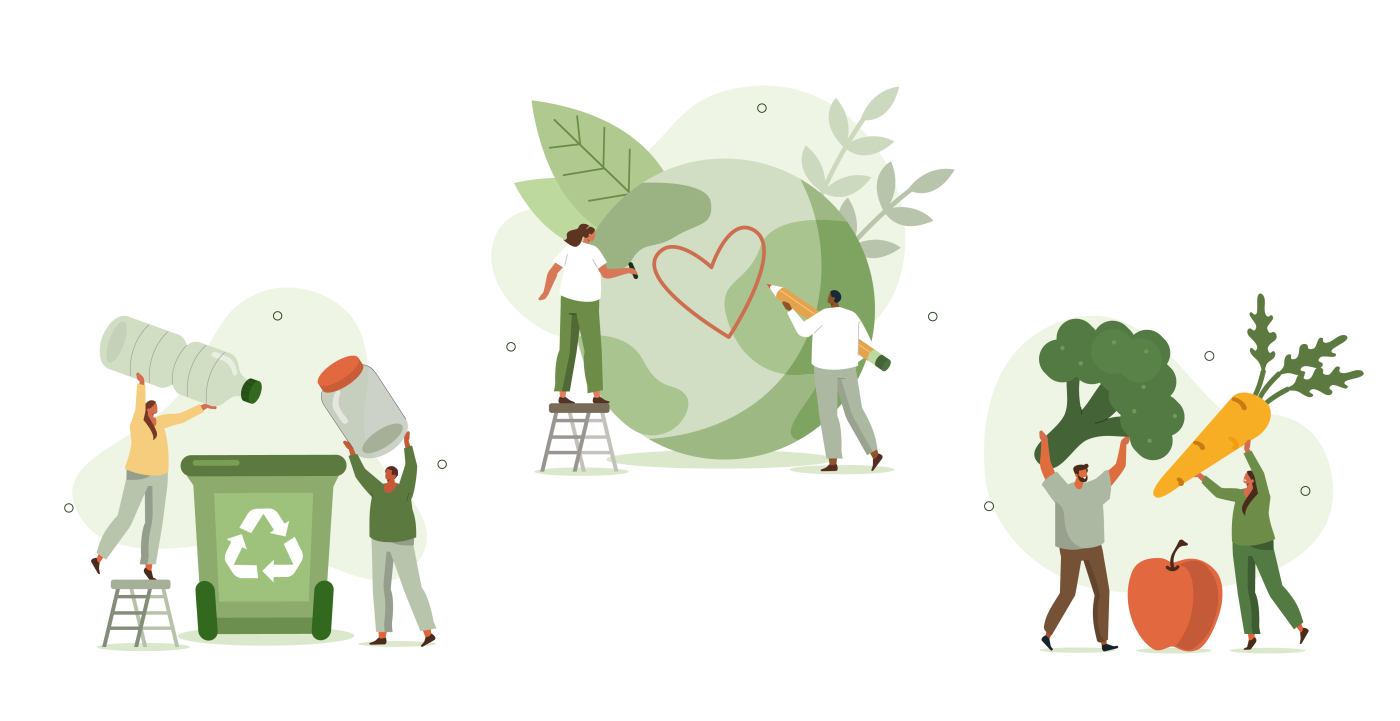
According to Ipsos, nearly 60% of French people plan to eliminate excessive packaging to combat climate change – a raised fist that pushes companies to adopt eco-friendly packaging strategies.
Facing growing environmental impact, eco-friendly design plays a crucial role in reducing food waste. The use of recyclable materials allows for eco-designed packaging to drastically reduce the amount of plastic used.
Make way for biodegradable, compostable, and recyclable packaging, which offer thoughtful alternatives to single-use items.
For nearly 15 years, DADDY has been collaborating with CBA Design to bring meaning back to the use of sugar by reinventing it in everyday life!
The agency has chosen a radical product innovation, kraft paper; a 100% recyclable packaging that significantly reduces its user’s environmental impact while remaining resistant to the most extreme conditions in pastry.
In concrete terms, this project reconciles meaning and utility for this historic brand.

Faced with pesticides, additives, and junk food, consumers no longer want to be carried along without knowing where they are headed. They need transparency; they more than ever need to know what they are eating.
Many designers are now reimagining the way food products are made. From the development of plant-based meat substitutes to the creation of healthy and nutritious snacks, food design emphasizes sustainable ingredients to meet the needs of the planet and health-conscious consumers.
Facing the additives and ultra-processing industry, raw, local, and organic products are once again becoming a necessity – a return to the true sources of nature.
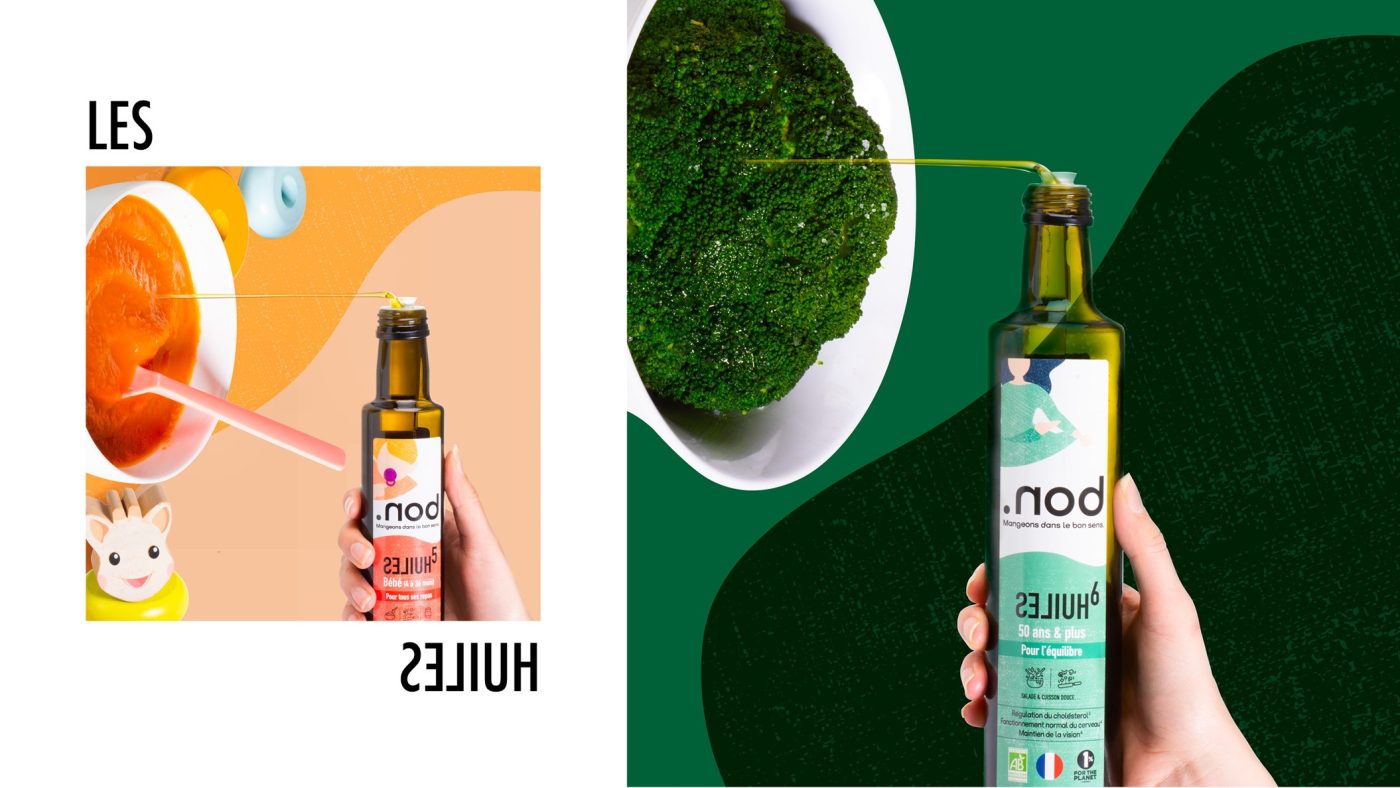
BIOFUTURE, a specialist in pesticide-free oils, has decided to change direction and advocate for a new standard: one that is good, with no compromise, for both us and our environment.
CBA Design supports them in creating their new brand, .nod, which exemplifies this fight by challenging what normality should be: eating in the right way.
Design goes beyond individual products and also applies at the scale of food systems.
Creating shorter supply chains, optimizing logistics, reducing food waste… Design Thinking strategies answer numerous needs and promise a better future. In a world where 2.5 billion meals are wasted every year (Too Good to Go), an increasing number of innovative initiatives are emerging.
According to the government, 10 million tons of food are wasted every year in France.
The Too Good To Go app allows for a significant impact by rescuing unsold items and transforming them into anti-waste baskets at very advantageous prices.
A pure Design Thinking product, thanks to an interface that “connects merchants with unsold items on their hands and residents ready to pick up baskets that would have ended up in the trash.”
Results?
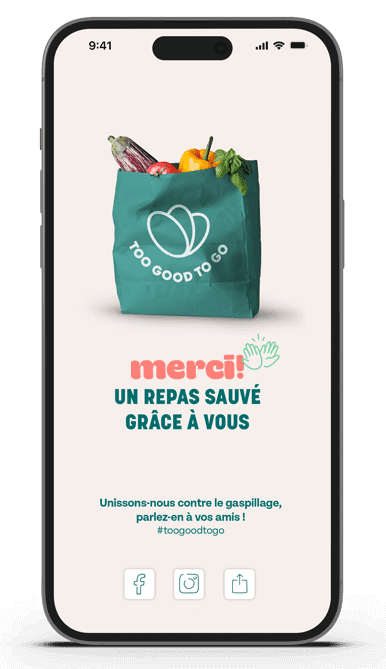
Sustainable food is a complex challenge, but design offers remarkable opportunities to find innovative and creative solutions.
By encouraging collaboration between designers, brands, and consumers, let’s create a future where design and sustainable food go hand in hand to build a better world!
Today we are going to talk about design (no surprise there) but not any design. The design of the future. The one that moves the lines, the one that juggles inclusivity innovation, ecology, and customization. Not that easy to describe this concept as it constantly evolves, in regards to emerging trends in technology, lifestyle, sustainability and culture. However, together we will try to predict the future.
It’s difficult to predict exactly what the design of the future will look like. But, we can identify some current trends that could influence the design of the future. What will be the main pillars of the new consumers? What will be the emerging aspirations that brands will have to consider? Here’s a non-exhaustive list to help you see this more clearly.
Today we are going to talk about design (no surprise there) but not any design. The design of the future. The one that moves the lines, the one that juggles inclusivity innovation, ecology, and customization. Not that easy to describe this concept as it constantly evolves, in regards to emerging trends in technology, lifestyle, sustainability and culture. However, together we will try to predict the future.
It’s difficult to predict exactly what the design of the future will look like. But, we can identify some current trends that could influence the design of the future. What will be the main pillars of the new consumers? What will be the emerging aspirations that brands will have to consider? Here’s a non-exhaustive list to help you see this more clearly.
Designers are looking to create products that minimize environmental impact and are sustainable; like Cazoolo which is Braskem’s packaging design lab. It’s an innovative hub that hosts a creative community, where consumers, entrepreneurs, designers or startups can meet to rethink packaging from a more sustainable design approach, designing the entire process -from conception to post-consumption- with a view to circularity and reducing environmental impact. Indeed, the watchword will be -and already is- to be more sustainable and environmentally friendly with recyclable materials, environmentally friendly manufacturing processes and reusable products.
Designers are looking to create products that minimize environmental impact and are sustainable; like Cazoolo which is Braskem’s packaging design lab. It’s an innovative hub that hosts a creative community, where consumers, entrepreneurs, designers or startups can meet to rethink packaging from a more sustainable design approach, designing the entire process -from conception to post-consumption- with a view to circularity and reducing environmental impact. Indeed, the watchword will be -and already is- to be more sustainable and environmentally friendly with recyclable materials, environmentally friendly manufacturing processes and reusable products.
Added to this is the fact that new consumers are looking for authenticity and simplicity above all! This means products that are honest, transparent, with a clear history or origin. No more products that are industrially produced or have a very (too) complex list of ingredients.
Added to this is the fact that new consumers are looking for authenticity and simplicity above all! This means products that are honest, transparent, with a clear history or origin. No more products that are industrially produced or have a very (too) complex list of ingredients. Some brands are already offering the experience of truth in fighting the absurdity of the food industry, like the brand, .nod.
This development is partly linked to a growing awareness of the environmental and social impact of consumption. In the end, consumers are looking for brands that match their values and lifestyle, and that are in line with their worldview.
Added to this is the fact that new consumers are looking for authenticity and simplicity above all! This means products that are honest, transparent, with a clear history or origin. No more products that are industrially produced or have a very (too) complex list of ingredients. Some brands are already offering the experience of truth in fighting the absurdity of the food industry, like the brand, .nod.
This development is partly linked to a growing awareness of the environmental and social impact of consumption. In the end, consumers are looking for brands that match their values and lifestyle, and that are in line with their worldview.
Let’s continue our predictions with innovation and technology. How can we miss this growing phenomenon that promises to bring many benefits to our society? Our media is being invaded by ChatGPT, AI, Metaverse and many others. These technological advances could transform the way we design our products, services and spaces. Virtual and augmented realities could enable immersive experiences in virtual environments, while 3D printing could allow for increased customization of products. This could greatly enhance the user experience by allowing consumers to interact with brands and the products they offer.
These technological developments will also allow brands to offer consumers a personalized experience based on their preferences and needs.
One of the key pillars for companies will be to address the needs of ALL users by reaching out to audiences previously invisible to certain markets with more accessible and inclusive designs that will have to become the norm. Some brands have already understood this, such as Dove with its commitment to body positivity #NeverBeforeRetouch and its “Real Virtual Beauty” campaign, challenging the representation of women in video games to help make the virtual world a positive space for everyone. Inclusivity is no longer a niche market, it’s and will be part of our daily lives and values!
One of the key pillars for companies will be to address the needs of ALL users by reaching out to audiences previously invisible to certain markets with more accessible and inclusive designs that will have to become the norm. Some brands have already understood this, such as Dove with its commitment to body positivity #NeverBeforeRetouch and its “Real Virtual Beauty” campaign, challenging the representation of women in video games to help make the virtual world a positive space for everyone. Inclusivity is no longer a niche market, it’s and will be part of our daily lives and values!
To conclude, it’s important to note that design is a constantly evolving field and that these trends are only forecasts; the future is unpredictable. These trends can change rapidly depending on political, economic, social and technological events in the world.
To stay informed of these developments: subscribe to the CBA Design’s newsletter!
The metaverse is a virtual, immersive, and interactive space, and among the giants of the metaverse, we find the French company The Sandbox, the Argentinean company Decentraland, and the Canadian company Roblox. Despite this excitement for the metaverse by brands, we can see that a portion of the French population is not receptive to these immersive universes. According to an IFOP study published in early 2022, 41% of 18-49 year olds have heard of the metaverse, and 75% of French people have concerns about it.
However, more and more brands are rushing to use this tool, including luxury giants such as Gucci, Tiffany & Co, Balenciaga, and Guerlain. McKinsey Institute stated last June that 95% of business leaders expect a positive impact on their sector.
The metaverse is a virtual, immersive, and interactive space, and among the giants of the metaverse, we find the French company The Sandbox, the Argentinean company Decentraland, and the Canadian company Roblox. Despite this excitement for the metaverse by brands, we can see that a portion of the French population is not receptive to these immersive universes. According to an IFOP study published in early 2022, 41% of 18-49 year olds have heard of the metaverse, and 75% of French people have concerns about it.
However, more and more brands are rushing to use this tool, including luxury giants such as Gucci, Tiffany & Co, Balenciaga, and Guerlain. McKinsey Institute stated last June that 95% of business leaders expect a positive impact on their sector.
But why are these brands investing such large budgets in this new communication channel? Firstly, the metaverse is a universe primarily used by the Generation Z. These brands are trying to reach this audience through this channel, and design in the metaverse appears to be the preferred means of addressing this young generation. The metaverse is a fantastic tool for creation and design and allows for the expression of a brand’s identity and universe, the creation of a unique and differentiated experience, and the sparking of curiosity among many.
The metaverse represents a new territory for brands to conquer, where the possibilities are infinite. Between fashion shows in the metaverse, creating an online store, or an immersive exhibition, Printemps has recently entered the virtual world by creating its “virtual store“: users can discover Printemps with its architecture from a specific period and purchase items online. Printemps also offers an artistic experience, as users can explore the crypto art collection of painter Romain Froquet. Retail and branding are being reimagined and adapted to the virtual world.
Ralph Lauren has created its own game on the Roblox platform, titled “The Ralph Lauren Winter Escape“. This is an opportunity for the American fashion brand to showcase its collection of winter sportswear, which will only be available for purchase on the Roblox platform. Ralph Lauren is “gamifying” its customer experience and inviting users to discover its brand universe through a unique virtual experience.
Se Loger, a French real estate company, offers virtual tours of apartments and houses directly in the metaverse. This is a way for potential buyers to better visualize the property they are interested in. Buyers can visit the property using their mouse and chat with the real estate agent in real-time. The customer journey is completely revamped to provide a unique and entertaining buying experience. The metaverse appears here as a way to blend the best of both worlds: a virtual tour that allows for total immersion, which will ultimately lead to a real-world experience.
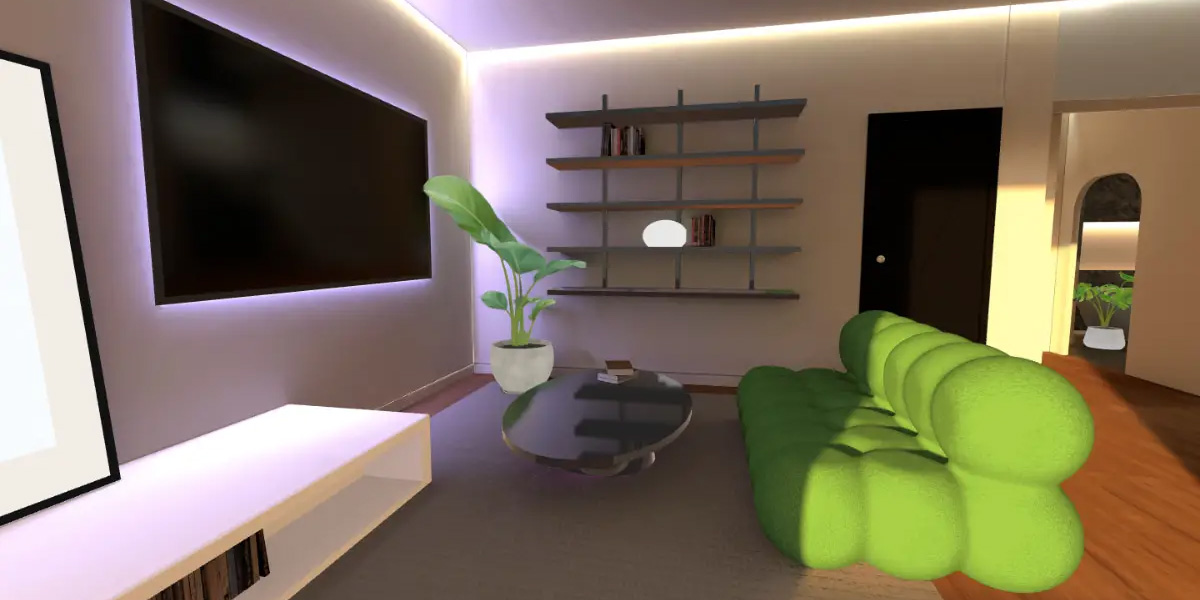
Tiffany & Co, the famous iconic jewelry brand, goes even further by selling 250 NFTs, the “NFTiff“, online on the metaverse. Buyers could purchase these NFTs and in exchange receive a custom-made pendant in gold and precious stones. Once again, the metaverse allows brands to innovate and offer a highly exclusive experience.
Tiffany & Co, the famous iconic jewelry brand, goes even further by selling 250 NFTs, the “NFTiff“, online on the metaverse. Buyers could purchase these NFTs and in exchange receive a custom-made pendant in gold and precious stones. Once again, the metaverse allows brands to innovate and offer a highly exclusive experience.
As these numerous examples illustrate, the metaverse is a way to express infinite creativity, reach and address a younger audience, but above all to rework the customer experience.
Business design is an operational style that combines business, strategic, and analytical approaches with the practices and mental model of design. It helps structure how each element of a business model affects the experience of customers and users.
In other words…
The discipline works at the intersection of feasibility, viability, and desirability to create innovation, helping companies and organizations move from point A to point B through a designed business model, or business model created based on the design approach.
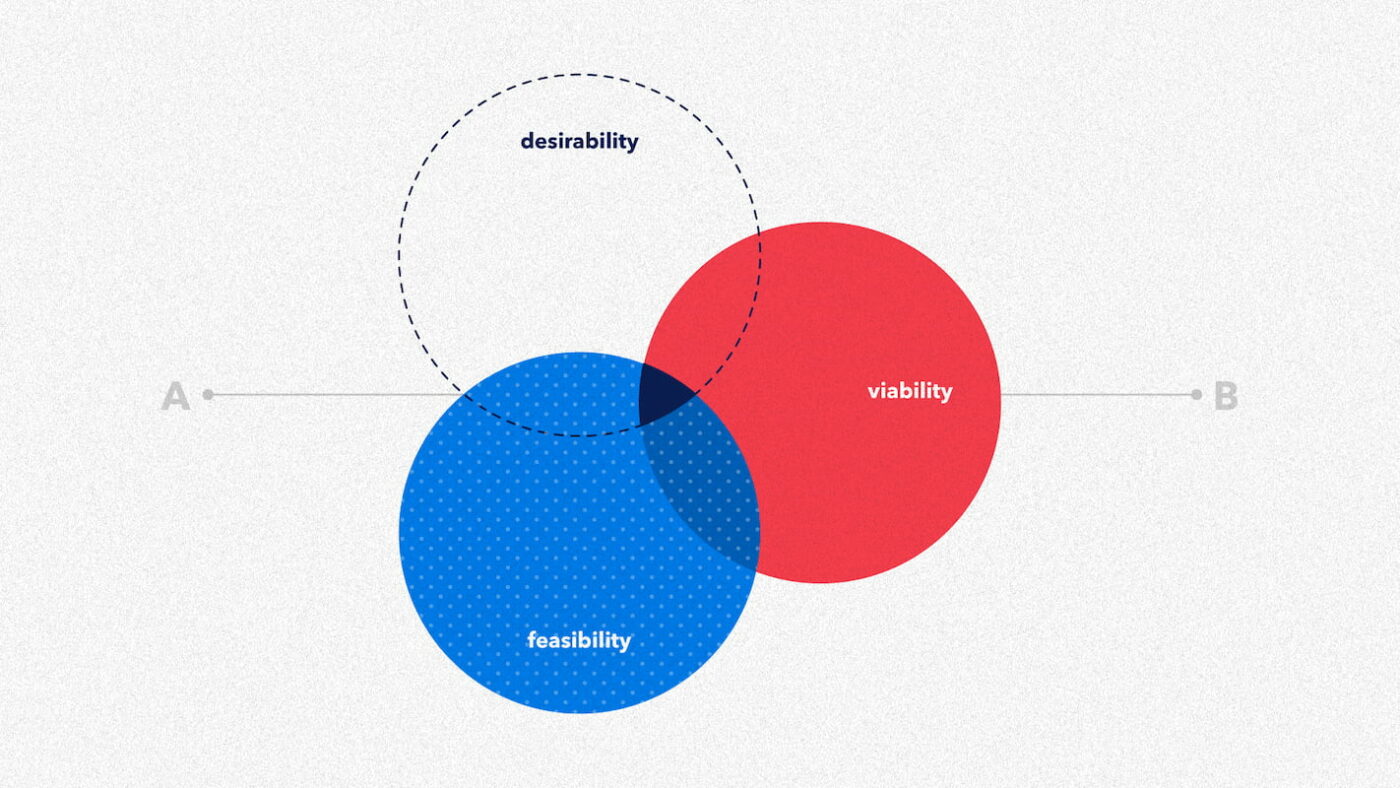
In the BANI (“B:rittle, A:nxious, N:on-linear and I:ncomprehensible”) world we live in, business design can be extremely valuable to a company. The growth of startups, rapidly shifting markets, and ever-evolving technological possibilities require the creation of innovative business models and the reassessment of conventional ones. Business design, among other things, provides the tools and methods to develop and test business models with a truly human-centered value proposition. But the discipline addresses many other issues. Here are some of its applications:
It is a strategy that can help brands and businesses overcome a variety of problems, but how does this relate to the design approach? How does a business designer act in the design process?
The three primary functions of a business designer during a design process are:
1. Use a business perspective to guide or inform the design process in order to make sure that the final product effectively addresses business issues.
2. Translate design solutions into value and impact using a language that business stakeholders are familiar with in order to prove that design provides solutions to business problems.
3. Use human-centered methodologies to strengthen the commercial and financial aspects of design work to produce services and products that are viable.

To understand what is meant by business design and the mindset of business designers, it is essential to keep in mind four major pillars: multidisciplinary approach, abductive reasoning, customer focus, and prototyping.
Design thinking emphasizes the value of assembling a diverse team, including the different stakeholders and users of the company’s product or service, to avoid having one viewpoint dominate the outcome. This combination enables us to examine the issue from various angles and ask the pertinent questions, such as: Is it desirable? Can we really do that? Does this make sense for my business?
2. ABDUCTIVE REASONING
Abductive reasoning derives from design thinking. Most business school programs teach deductive reasoning – from rules to conclusions – and inductive reasoning – from examples to rules. In clearly defined contexts, both deductive and inductive reasoning perform well. Working with businesses, however, frequently entails having access to insufficient information in a highly complex system. The concept of wicked problems, a term coined by Herbert Simon – a scientist and the inventor of design thinking, explains it: the more complex and multidimensional the problems, the more they demand a collaborative methodology and a deep understanding of human needs. Therefore, abductive thinking, a combination of inductive and deductive reasoning, is actually more suitable for such situations.
3. FOCUS ON THE USER
Business design uses user-centered and empathic design approaches. The starting point of any challenge is people. Every strategy is built based on a deep understanding of users, including information on their problems, objectives, and pain points. This helps us develop solutions that best fit their lifestyles.
PROTOTYPING
Business designers create prototypes not only to prove their validity but also to learn. To come up with the best-case scenario, we don’t simply consult a spreadsheet. We launch products and services to test the business. We develop financial projections and business cases to prove the financial viability of a product. We outline product ideas that represent strategic trade-offs to inform our strategic decisions. We create extreme business model scenarios and use them as prototypes to learn from customers, suppliers, and other stakeholders. We occasionally produce business pitches that help make new business ideas concrete so that organizations can support the development of spin-offs or fund a startup.
Business design is….
This year in 2023, the International Women’s Rights Day aimed to raise awareness for difficulties women face to access digital jobs all around the world. The hashtag #EmbraceEquity, heavily used on social media this month, takes a stand for equity above all else, especially in our digital era. Stick with us to learn more.
According to the Social Builder charity, 73% of digital professionals are men. To denounce the under-representation of women in this field, Social Builder diverts the situation by prohibiting job offers to women, masked by a “gendered content” warning.
A shock awareness campaign for women’s rights. Check it here.
To encourage accessibility, two key themes have been chosen this year:
The two cannot go without each other because: without equity, we cannot achieve equality.
Regardless of the industry, companies are the first on the line who must “put technology for a safer, more sustainable and fairer future”(UN WOMEN).
More and more brands today incorporate the concept of inclusivity into their products’ design or their communications strategy to celebrate accessibility.

Tout comme la filière tech, le design aussi se doit de suivre ce chemin de sensibilisation en se mettant de plus en plus au service de l’inclusion féminine.
Through inclusive design, brands today strive to celebrate diversity and empowerment of minorities. Normalizing bodies, de-gendering products or celebrating multiculturalism are part of multiple inclusivity strategies to enable accessibility.
To be consistent with the values of our 3.0 era, brands today are encouraged to:
Design is a powerful tool to strengthen the empowerment of women. How? By creating products and services that meet their needs and allow them to better understand their environment; that is a real power tool. Whether it is the product itself, its packaging, or the communications strategy, brands are invited to give women greater self-confidence.
By involving women in the process of designing products and services that affect them, brands give them a sense of active participation and responsibility. Surveys, interviews or focus groups allow brands to understand the state of mind of consumers and their needs, whether it’s physiological (body), psychological (self-esteem) or social (belonging).
CBA LATAM – our studio in Latin America – was able to support KIMBERLY-CLARK, the American leader in sanitary protection, in the design of an application aimed at having several consumers test sanitary pad formats.
Consumers were invited to take a photo of their underwear to allow artificial intelligence to innovate the adaptability of the pad’s shape.
Thanks to various consumer tests, the brand was finally able to co-create the ideal product with its community. Discover the case here.
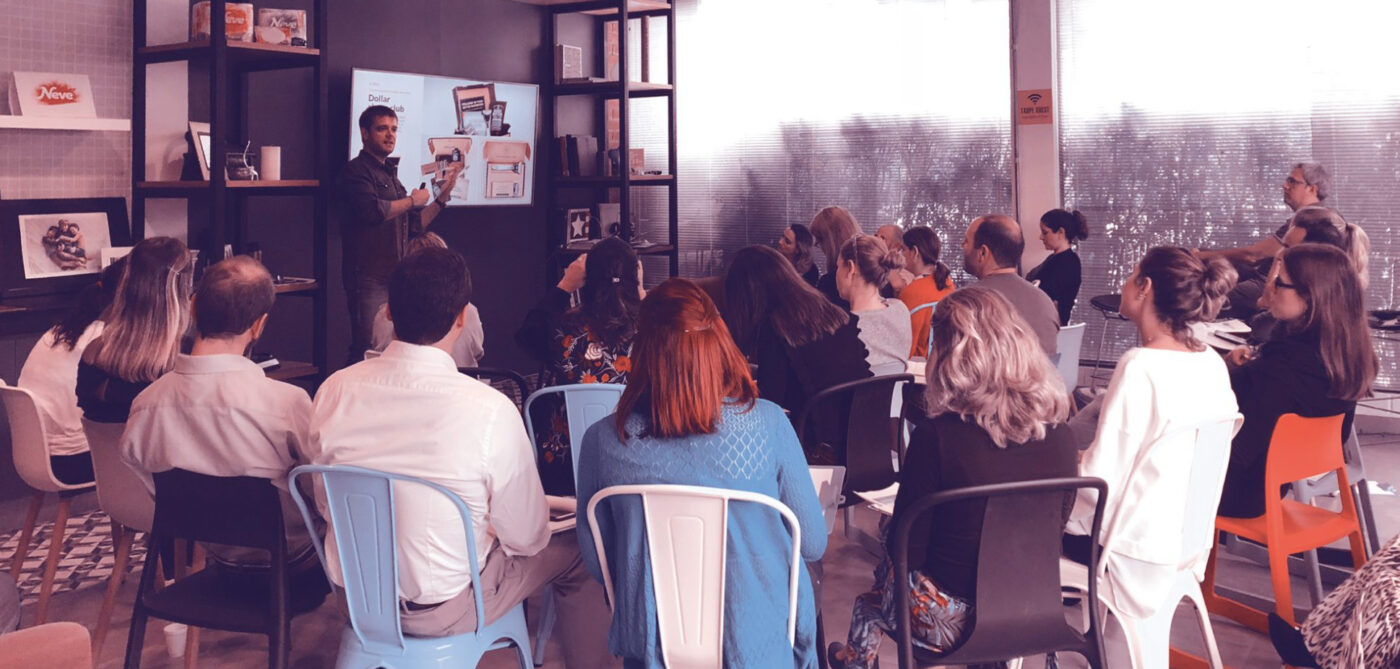
The representation of different identities on digital platforms also allows communities to be better highlighted, whether they’re a minority or not.
DOVE, in its “Real Virtual Beauty” campaign (2022), has made it a mission to “challenge the representation of women in video games in order to help make the virtual world a positive space for them”.
With avatars becoming ever-present in the gaming industry, it is a must today to design more inclusive digital spaces by highlighting multiple identities.
A study conducted by DOVE found that 60% of girls start playing video games before the age of 10. On the other hand, female characters in digital spaces are known to be highly sexualized with considerably stereotyped beauty criteria such as: unrealistic body dimensions, or sexualization through clothing, and so on.
Thus, as part of its “Real Beauty in Games” training program, DOVE aims to give video game developers proper education to “create a healthier and more diverse representation of girls and women in video games around the world”.
Results:
In addition to inclusiveness, design also contributes to strengthen empowerment by creating products and services accessible to all women, regardless of their disability, education level or social background. By using intuitive interfaces, design allows women to better understand their environment by considering issues of accessing information.
ORKID, the leader in sanitary protection in Turkey, launched a bold awareness campaign in 2019 against femicide and the social taboos associated with menstruation.
This is the statement of the brand: “In Turkey, sanitary pads are wrapped in newspapers at the time of purchase because of the shame associated with periods. In a society where violence, discrimination and injustice against women fill the newspapers, it is not selling sanitary pads that should be shameful”.

ORKID used a unique packaging idea by wrapping pad packs in printed newspapers with headlines referring to the main difficulties faced by Turkish women: “low employability and political representation, violence of gender and an insufficient literacy rate“.
This new packaging has met unprecedented success in sales while tearing public opinion apart.
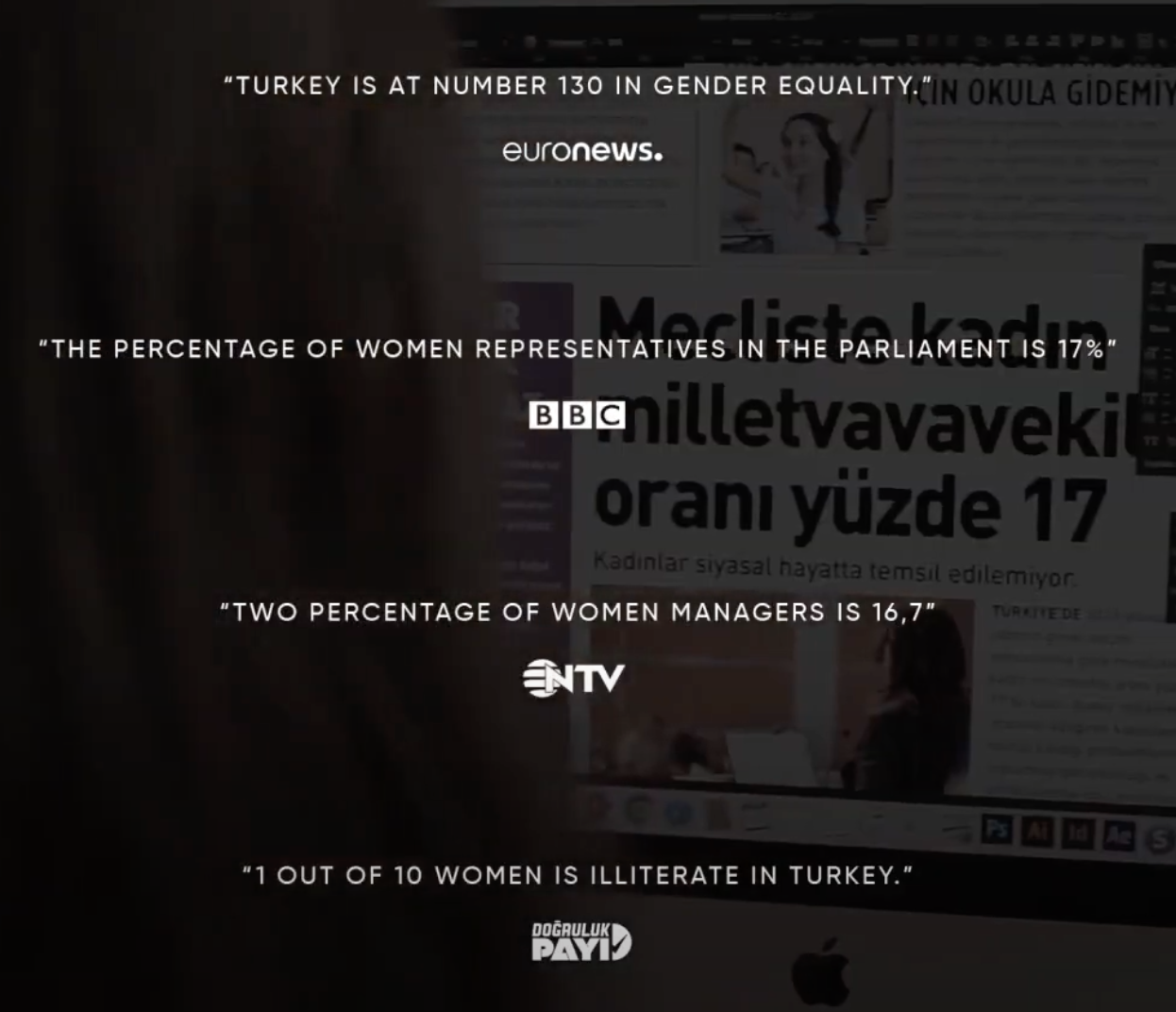
In conclusion, design in our era is intended to be a transformative power tool allowing women to speak out, celebrate their inclusion and strengthen their autonomy. Consumers ask brands to design their products considering gender equality issues and the diversity of their needs.
On the other hand, is neutrality now considered old-school in the tone of voice of a brand? Has taking a position become essential in product design or brand communication strategies? To meditate…
Download our Design Trends Report and follow our hottest empowerment design tips!
Check our Women’s Rights Month interviews with our collaborators in our Paris agency. Let’s meet in the comments section!
Written March 27th 2023 by Dilara Cetiner
With the constant questioning of women’s rights around the world and still today, we are well aware that some of the rights are still sensitive and unstable. The group CBA means to fight against gender discrimination and sexism and do believe that design is an extraordinary tool to shape the world into a better place, both for women and men.
Thus, CBA launched a campaign in March highlighting the women and men who fight gender inequality on a daily basis and the role of design in the inclusion of women.
We have sought to analyse the theme of women’s rights from all angles, in order to enlighten and raise public awareness.
CBA Paris launched an interview campaign highlighting employees and their experiences as women or men in the world of work and their perceptions of gender inequality. Here are a few questions they answered:
Margaux Lhermitte, Head of Retail & Architecture
Anthony Charton, Art Director
Léa Richard, Project Manager Assistant
Laurence Bethines, Brand Strategist
Nathalie Aupetit, Senior Artistic Director
Barbara Duavy, Managing Partners & Head of Culture CBA B+G, looks back on her experience as a woman in the professional world and especially as a board member. A touching, transparent and necessary testimony en today!
An interesting look at her childhood, her schooling and the objectives of CBA B+G in terms of people, culture, diversity and ESG, in the long run.
Thank you Barbara for your testimony!
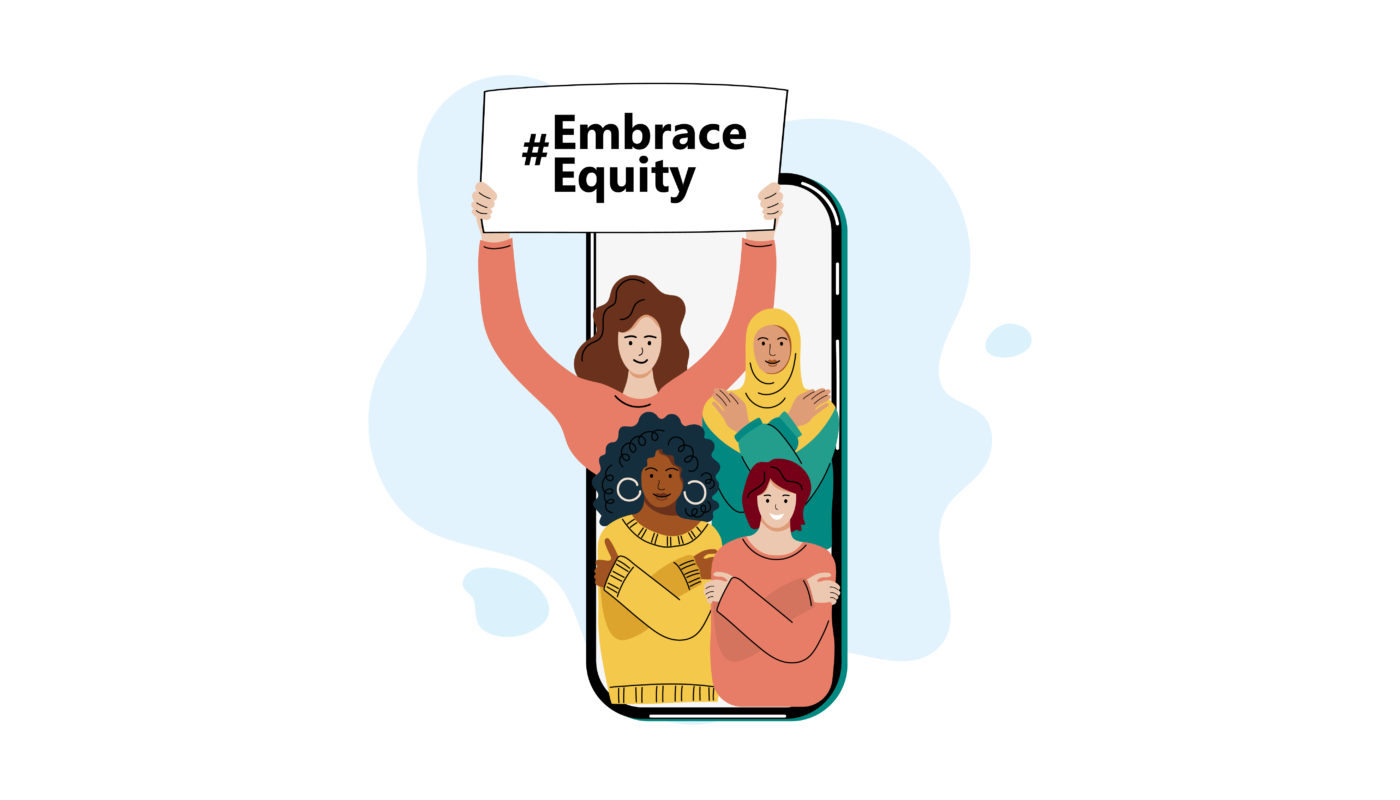
In this special month, we decided to focus on the theme of inclusive design. More and more brands adopt inclusive design to celebrate accessibility! In order to respond to issues that are still major today as fight against gender discrimination and sexism, celebrate a more intuitive and accessible design and adopt equity thanks to inclusives identities.
Carmen Beer, content manager at CBA B+G, highlights the ‘All Bodies are Normal’ trend from our recent Design Trends Report, which has everything to do with empowered women.
Embracing and celebrating the natural shapes and cycles of all bodies is the core of many new brands, designing products & services that speak directly to a target group previously forgotten.
Subjects as the well-being, mental health and acceptation are much more taking into account by brands. Authenticity and transparency is key!
Sandra Garcia, our Managing Director at CBA Spain, took part at the BCREATIVE session of the Barcelona Woman Acceleration Week with the key theme « Impact creativity led by women ».
A keynote about the power of design applied to business strategies to achieve responsible and sustainable growth.
A scene shared with Sisón Pujol, founder and CEO at Nonon Design agency, Ana Fornt, CEO at Group Efebé and Arantxa Bernadí, CEO at Bernadí.
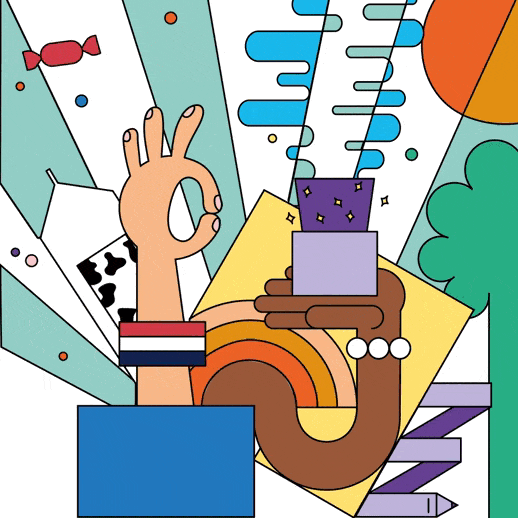
Did you know that on average a European produces nearly 180 kgs of packaging waste per year? Did you also know that, according to the European Commission, more than 40% of plastic materials and 50% of paper used in Europe are intended for packaging?
However, more and more consumers no longer want to put up with packaging in their daily lives. According to Ipsos, almost 60% of French consumers plan to remove excessive packaging to fight climate change. Nearly half of American consumers are willing to pay more for their products for recyclable or reusable packaging.
The environmental cause affects us all. More than half of us adjust our behavior to become more responsible and contribute on our scale to the preservation of our planet.
That’s why this new awareness is pushing companies to innovate and come up with new eco-responsible packaging strategies.

Eco-responsible packaging, eco-friendly packaging or eco-packaging: all mean the same thing. It’s a packaging that limits its impact on the environment by considering its entire life cycle and without danger for its user.
Unlike what one might think, it’s not just limited to recycling! A multitude of concepts must be integrated. Here are few of them:
According to LSA Green, 90% of European consumers expect brands to commit themselves.
More and more brands are expected to invest in a new packaging design for their products in order to meet these new expectations and convictions required from their consumers. From luxury brands to cosmetics, or even agri-food, all types of industries are determined to eliminate plastic packaging.
Beyond attracting the consumer, packaging also allows a brand to communicate about its identity and values. An eco-friendlier packaging will allow brands to strengthen their image as committed companies. It will also help them to be in harmony with the desires of their customers and prospects.

And yes, more and more brands are launching innovative design and packaging solutions while being compostable and biodegradable.
Discover the Coffeeb capsules project from CAFE ROYAL. Forget all the aluminum ones… make room for small, compressed coffee balls, wrapped in a thin 100% biodegradable membrane!
Who hasn’t already been influenced by packaging when shopping? And yes, this is not new: packaging has a key role in consumer purchasing decisions, but is it as strong to transform impact our behavior for the very best?
Some brands have taken up the challenge and used the packaging of their products to raise consumers’ awareness about recycling and environmental cause.
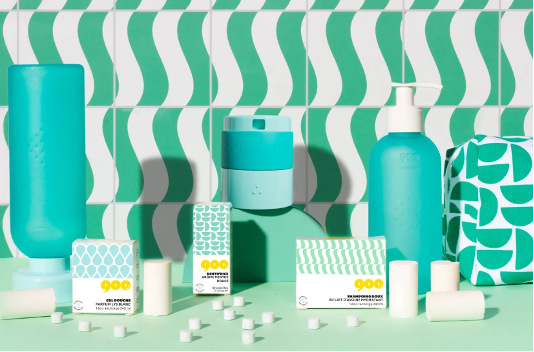
The 900 care brand is the perfect example of tackling the thorny problem of household pollution and the overconsumption of plastic. The company has designed a range of hygiene products as tablets that can be diluted in water to allow everyone to make their own products.
But what persuades us to change our habits? With their subscription system, you no longer need to worry! As soon as you run out of shampoo, you receive the refills directly at home.
Practical but also well-designed, the brand comes up with colorful refillable bottles that can also be used as decoration tools in our bathrooms.
CBA’s global team of designers, strategists and content experts have selected from out there what they considered top-notch in terms of design, branding and consumer trends, focusing on positive impact.
From this great curation we highlighted 15 trends that, in this year, will continue to encourage brands – large and small, from all categories – to innovate in order to become more useful to society.
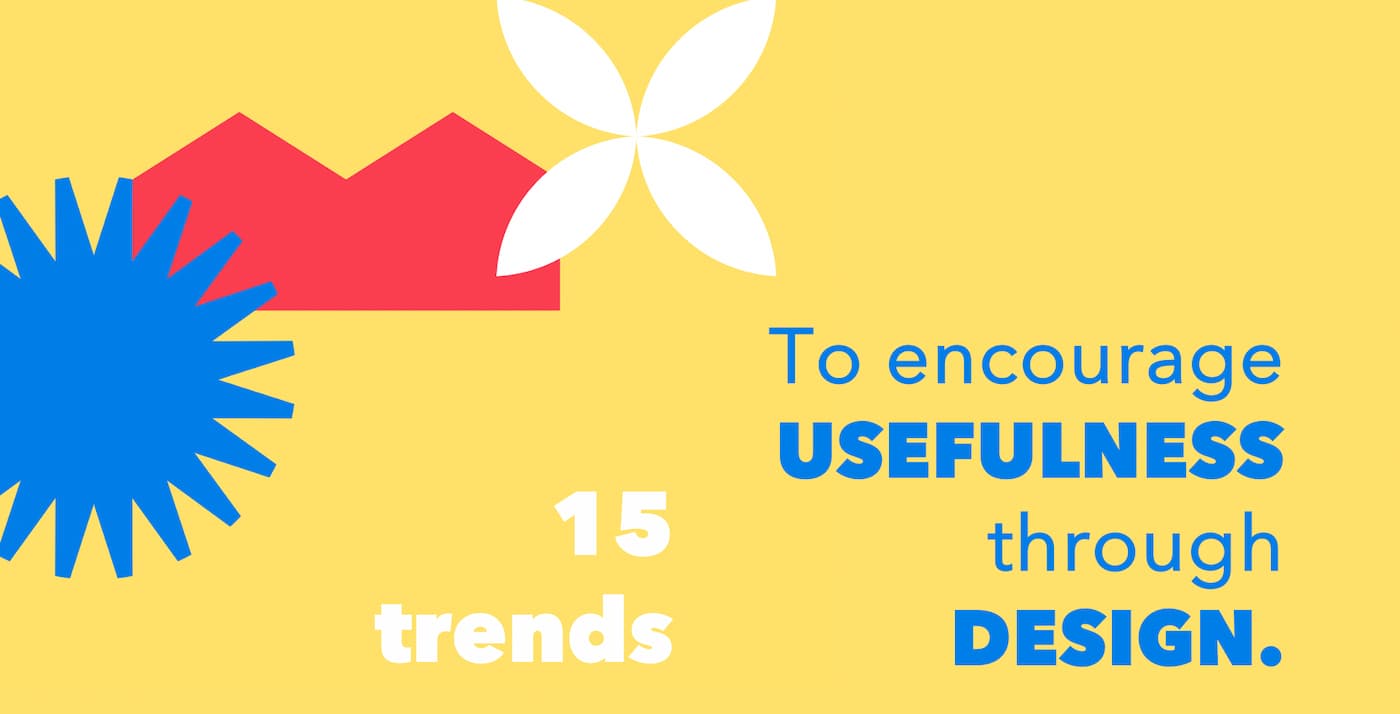
Trends are segmented into 5 pillars -pillars from the utility map of our Critical Imprint methodology:
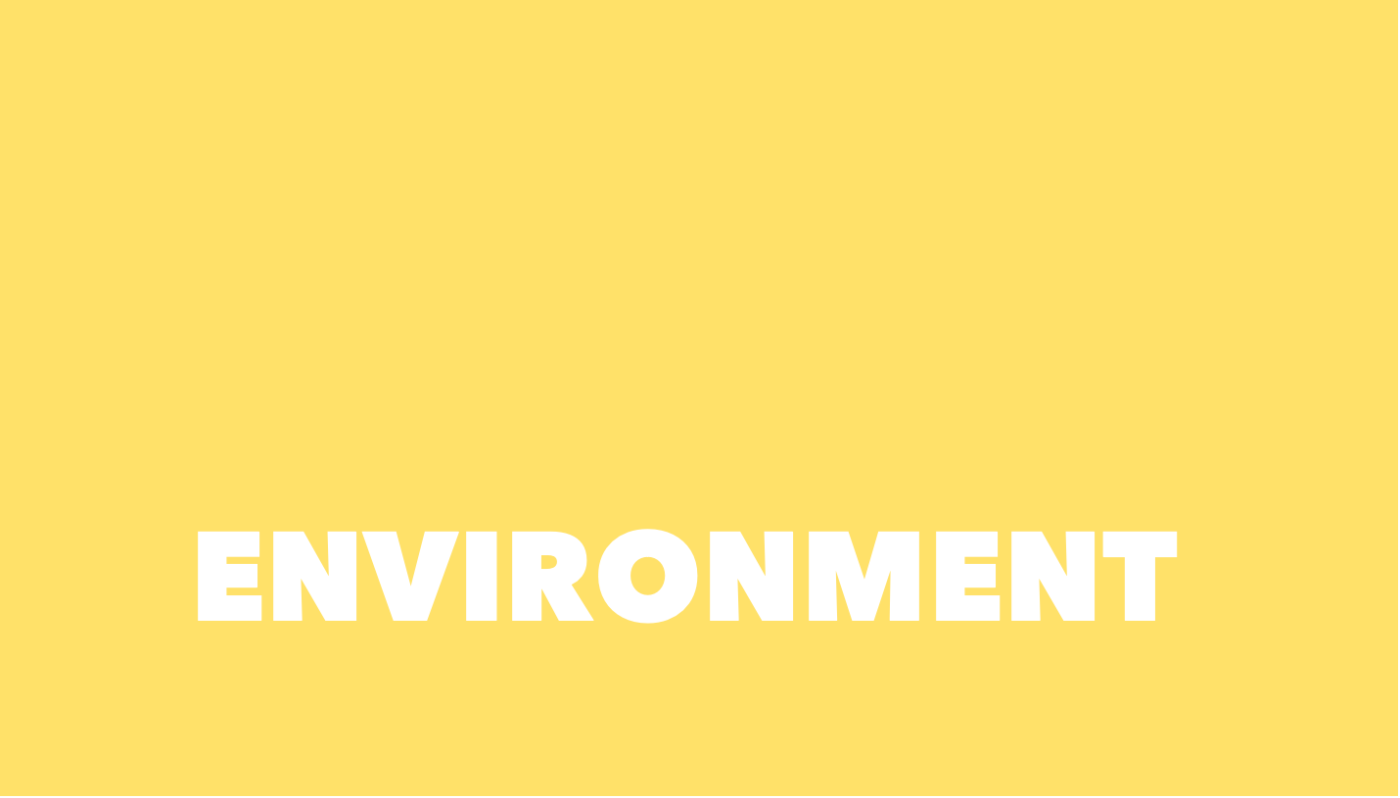
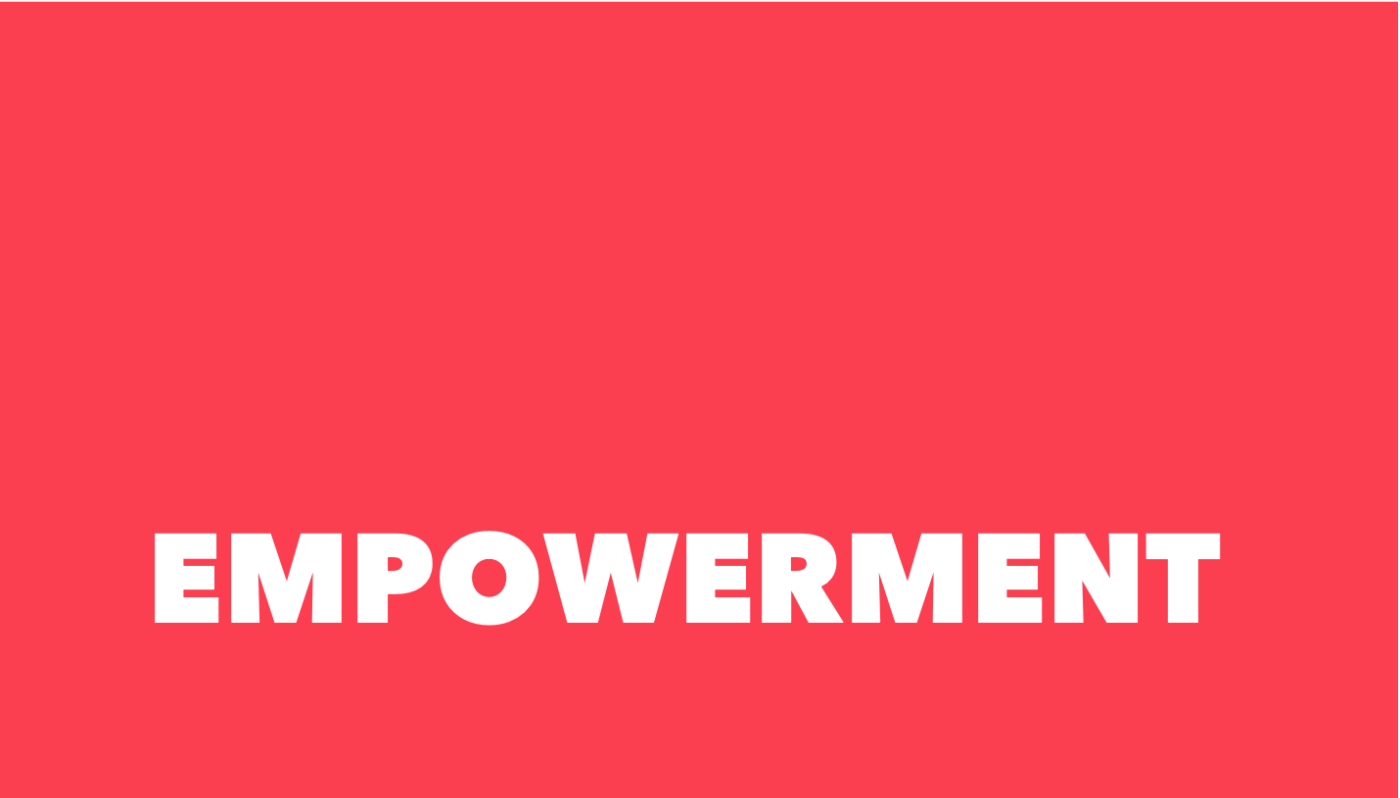
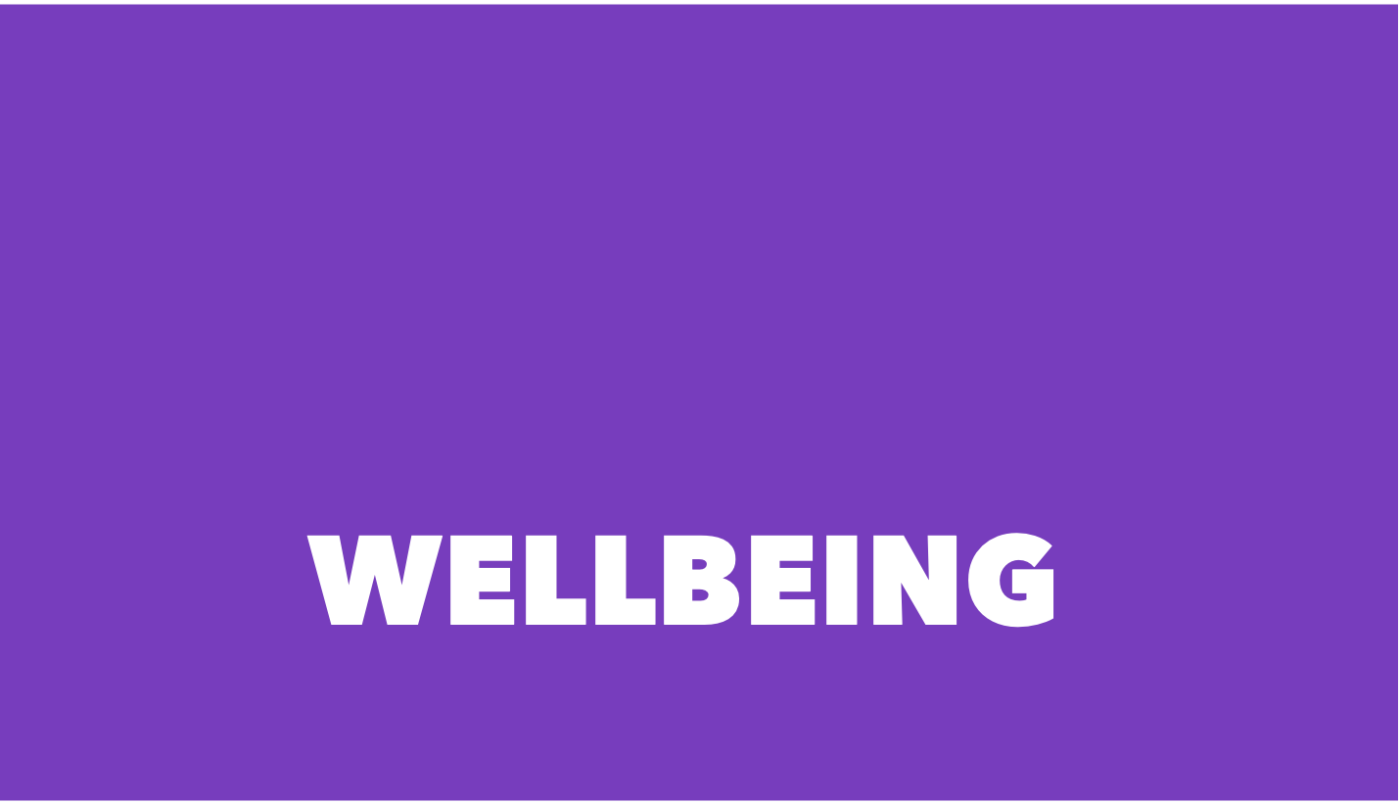
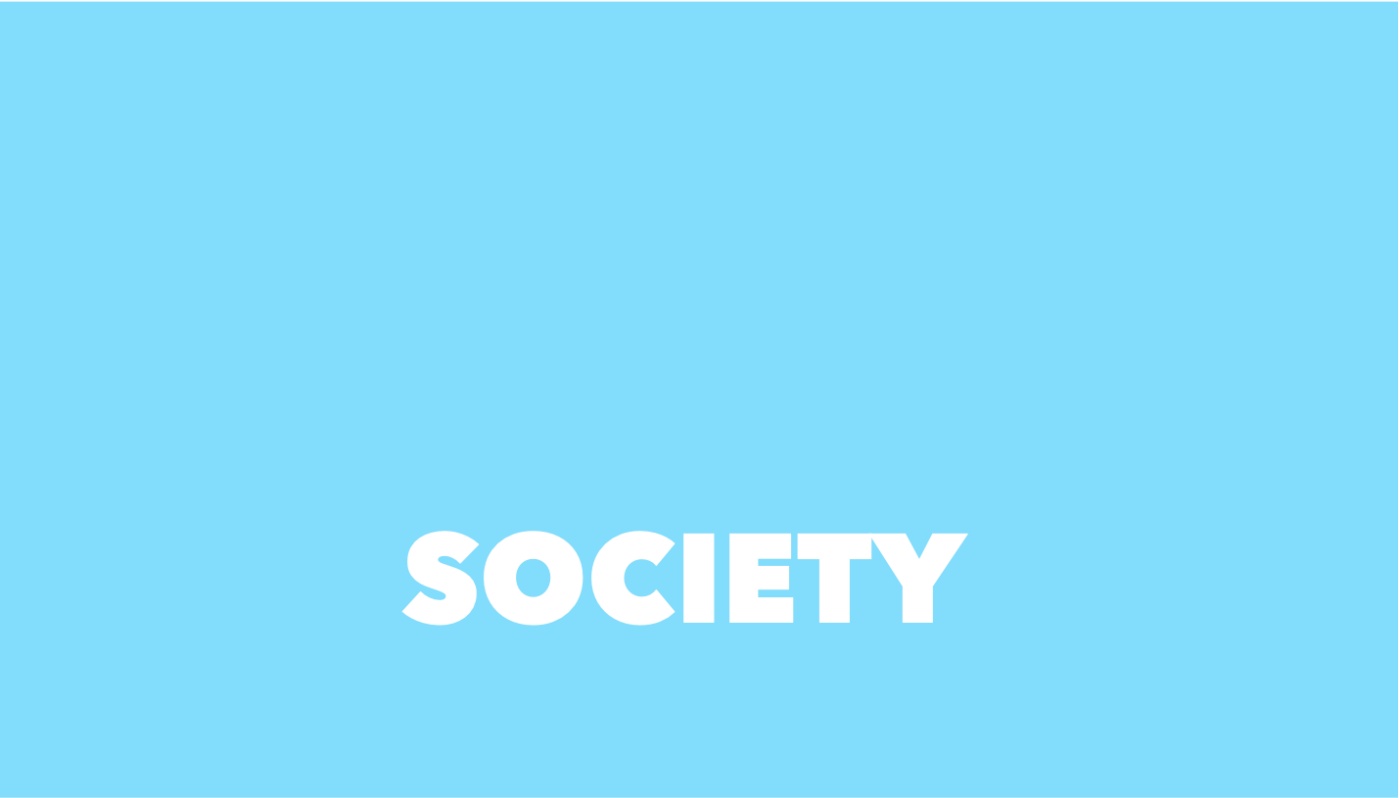
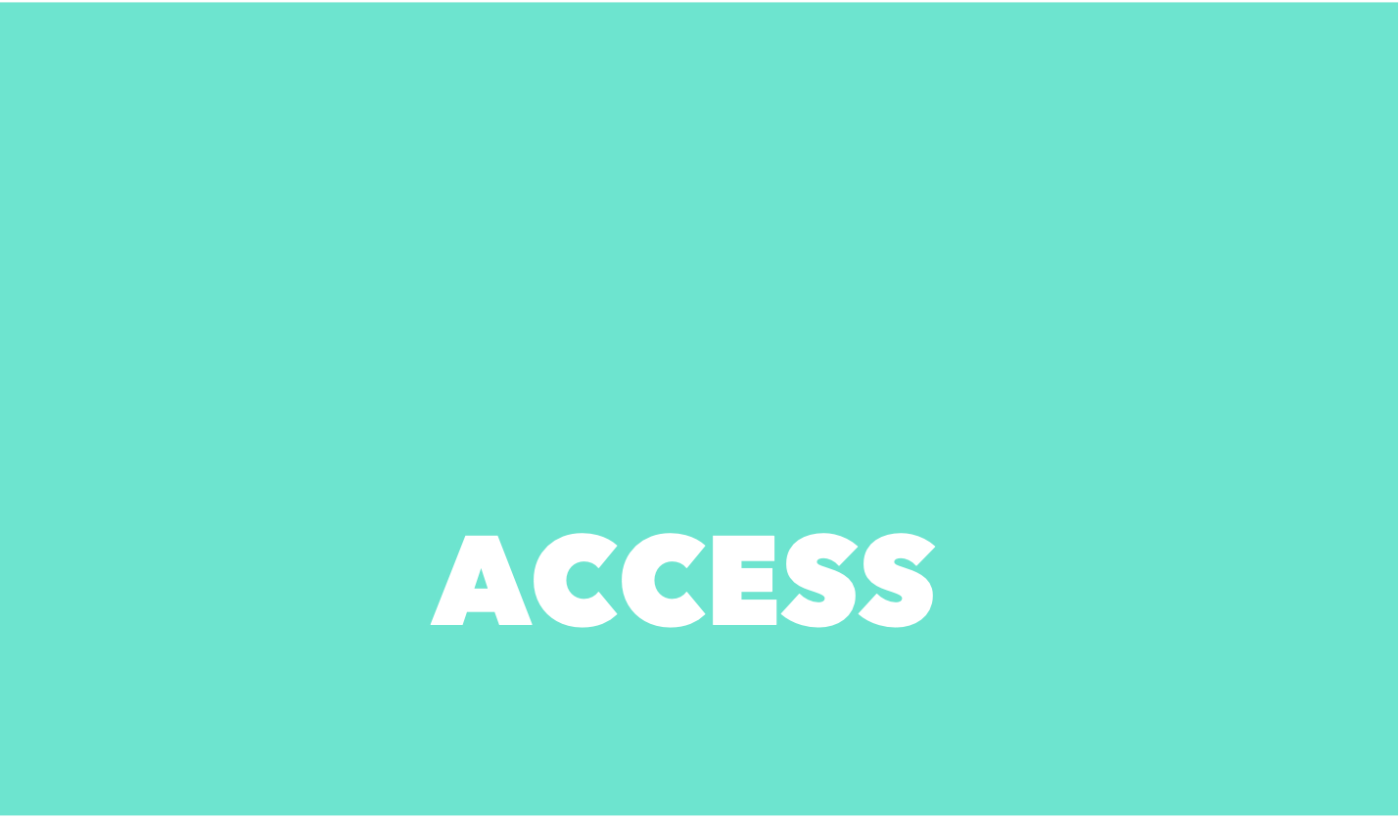
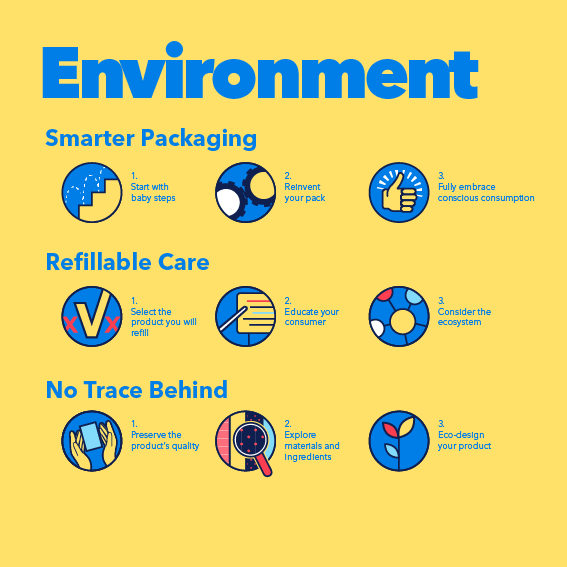
There is no Planet B, and we ought to take care of the one we live in.
Designing environmentally friendly packaging is a must: we need to consider the use of different packaging materials and formats.
Brands are increasingly celebrating

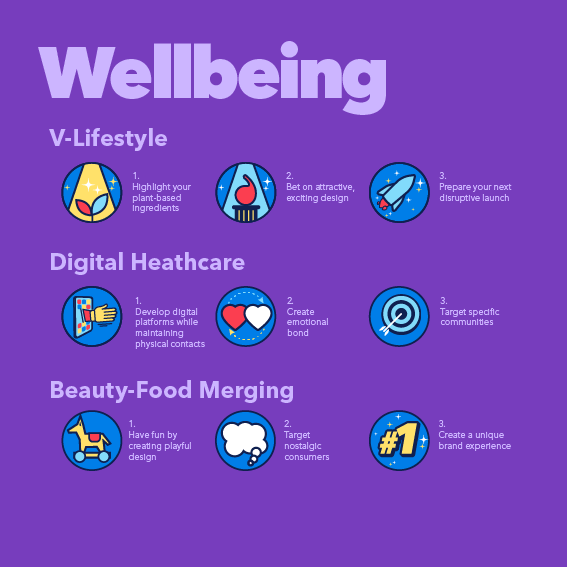
a boom of digital healthcare solutions catered to communities, and a playful integration between beauty and food brands.
The pandemic and the ongoing process of globalization
have many of us questioning what is it that we want for
our future as a society
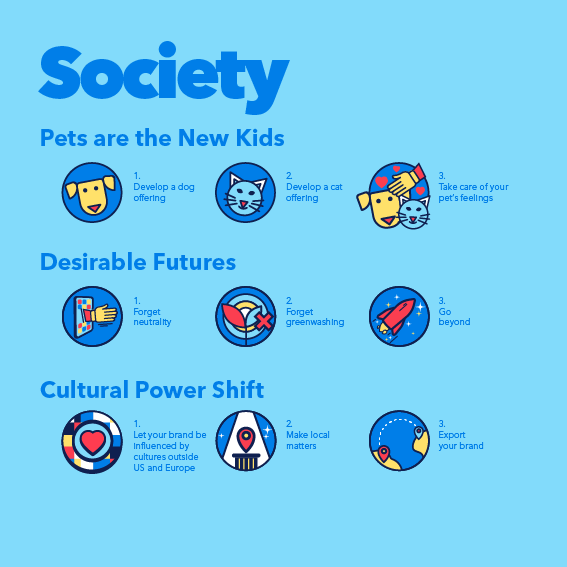
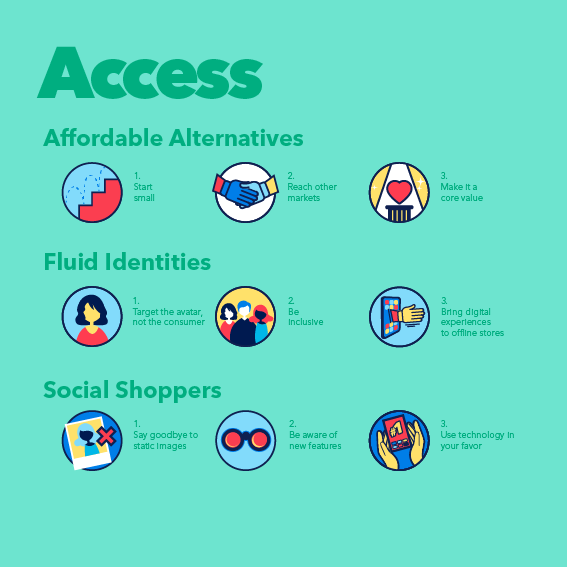
by making their offer more economically affordable, or expanding their presence in the metaverse and on social media.
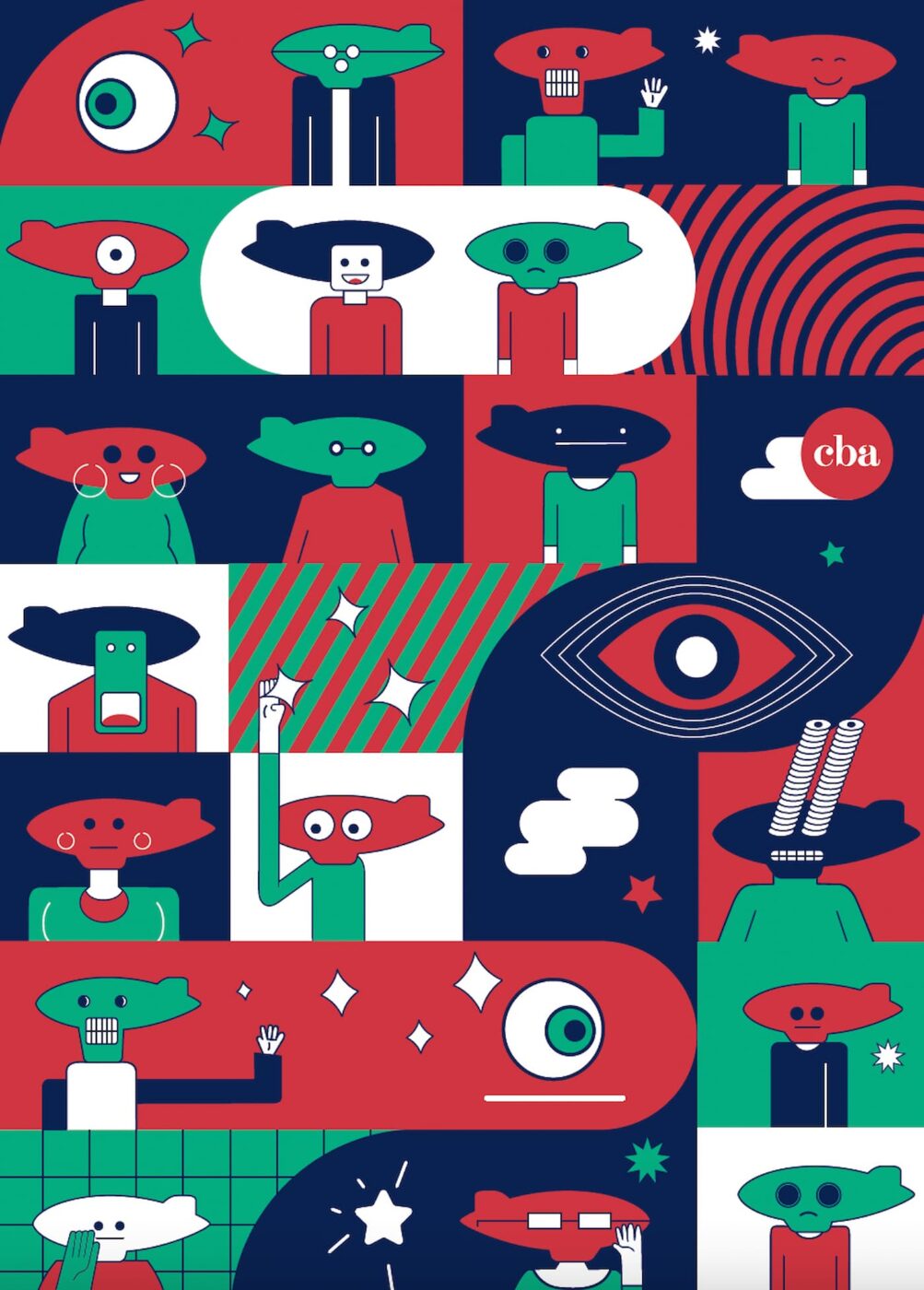
In 2022, The Good Company and the study institute Kantar launched the Inclusion & Diversity in Advertising barometer.
The goal? « Confronting the perception and expectations of the French people with the reality of advertising content ».
72% of the French consumer think that « showing diversity in advertising is important, even very important ». It’s a high number that shows that the population wants to see more inclusive advertising that celebrates diversity. The consumer changes, evolves, and becomes more and more uncompromising towards brands. He is looking for brands that represent its values.
According to a study carried out by Environics Research and Amazon Ads, 72% of American consumers and 60% of Europeans consumers « aspire to more diversity and representation in advertising ». Thus, between the consumer and the emergence of cancel culture, brands must react.

In 2022, The Good Company and the study institute Kantar launched the Inclusion & Diversity in Advertising barometer.
The goal? « Confronting the perception and expectations of the French people with the reality of advertising content ».
72% of the French consumer think that « showing diversity in advertising is important, even very important ». It’s a high number that shows that the population wants to see more inclusive advertising that celebrates diversity. The consumer changes, evolves, and becomes more and more uncompromising towards brands. He is looking for brands that represent its values.
According to a study carried out by Environics Research and Amazon Ads, 72% of American consumers and 60% of Europeans consumers « aspire to more diversity and representation in advertising ». Thus, between the consumer and the emergence of cancel culture, brands must react.

In 2022, The Good Company and the study institute Kantar launched the Inclusion & Diversity in Advertising barometer.
The goal? « Confronting the perception and expectations of the French people with the reality of advertising content ».
72% of the French consumer think that « showing diversity in advertising is important, even very important ». It’s a high number that shows that the population wants to see more inclusive advertising that celebrates diversity. The consumer changes, evolves, and becomes more and more uncompromising towards brands. He is looking for brands that represent its values.
According to a study carried out by Environics Research and Amazon Ads, 72% of American consumers and 60% of Europeans consumers « aspire to more diversity and representation in advertising ». Thus, between the consumer and the emergence of cancel culture, brands must react.
According to a study carried out by Environics Research and Amazon Ads, 72% of American consumers and 60% of Europeans consumers « aspire to more diversity and representation in advertising ». Thus, between the consumer and the emergence of cancel culture, brands must react.
Brands’ authenticity is regularly questioned or pointed at. Are some brands legitimate? Authentic?
What brands are being criticized for is the lack of concrete proofs. A simple speech is not enough. It must be supported by actions.
————– Environics Research and Amazon Ads
Many brands are engaging in what is known as brand activism, i.e. the commitment of a brand, in a concrete way, to a social or environmental cause.
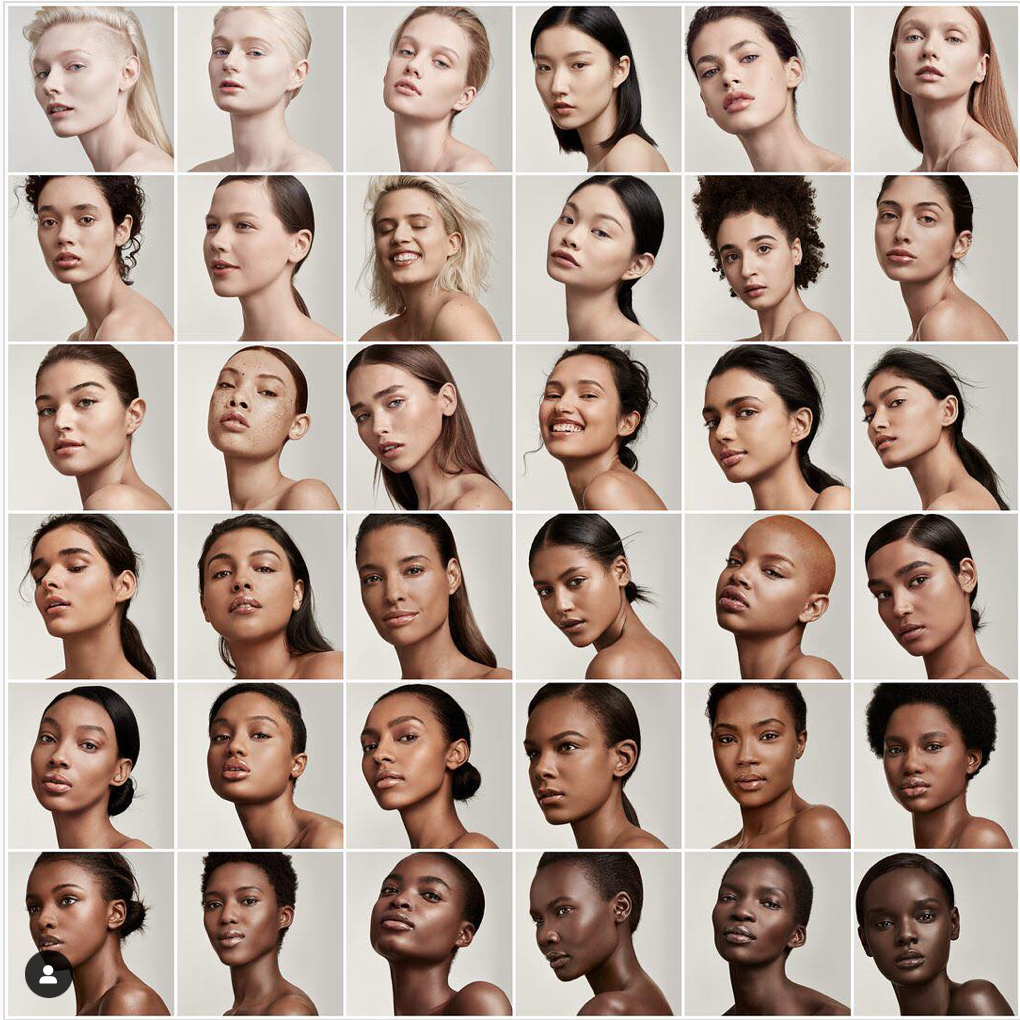
A concrete example is the brand Fenty Beauty, who launched more than 50 shades of foundation, in a market where it’s still difficult for black people to find a make-up product that matches their skin tone.
A concrete example is the brand Fenty Beauty, who launched more than 50 shades of foundation, in a market where it’s still difficult for black people to find a make-up product that matches their skin tone.

Gillette decided to question men stereotypes through its campaign called « The man your are » by highlighting a diversity of men when shaving. The goal? Break the codes. Gillette, in making that choice, wants to allow all men to feel represented when watching this ad.
The opulent expression of glamour & feminity has become dated and Lux has understood it well. The brand wanted to inspire women to rise above everyday sexist judgements & express their beauty & femininity unapologetically. Our teams redefined the brand’s purpose and accompanied Lux on the creation of its brand visual identity.
« Creative and developer, great artists, great feminists, big mouth, big heart (…) » … SNCF, the French public railway company, launched « Hexagonal », a video campaign, with the goal to federate its users by representing them through its advertising. A campaign rewarded by a Bronze Lion in the « Creative Strategy » category (Lion Cannes Creativity International Festival). A campaign to support the business plan launched in 2020 by the SNCF, which focuses on putting people at the heart of company, the development and vitality of territories, the ecological transition and digital mobility.
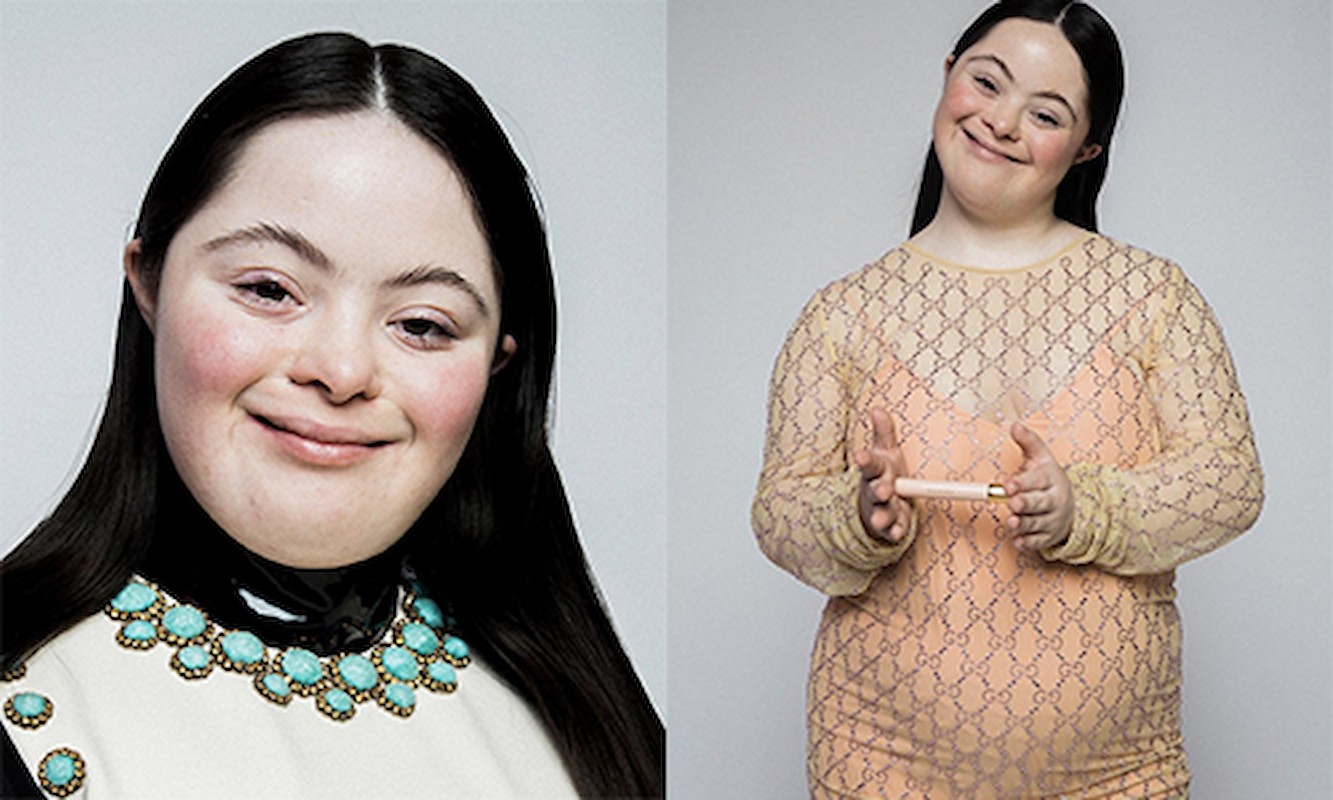
In 2020, the iconic luxury brand Gucci has chosen to appoint as the muse of its brand Ellie Goldstein, who has Down’s syndrome.
A bold choice since the market is still very stereotyped and standardized.
Gucci highlighted the effort to be made by the brands and denounced the lack of representation in of the market.
In 2020, the iconic luxury brand Gucci has chosen to appoint as the muse of its brand Ellie Goldstein, who has Down’s syndrome.
A bold choice since the market is still very stereotyped and standardized.
Gucci highlighted the effort to be made by the brands and denounced the lack of representation in of the market.

Other brands make the choice to rebuild completely their naming or visual identity. It’s the case of Aunt Jemina, which changes its name to Pearl Milling Company and erased the image of a black woman from its packaging ; caricature of the black nanny caring for the children of a white family.
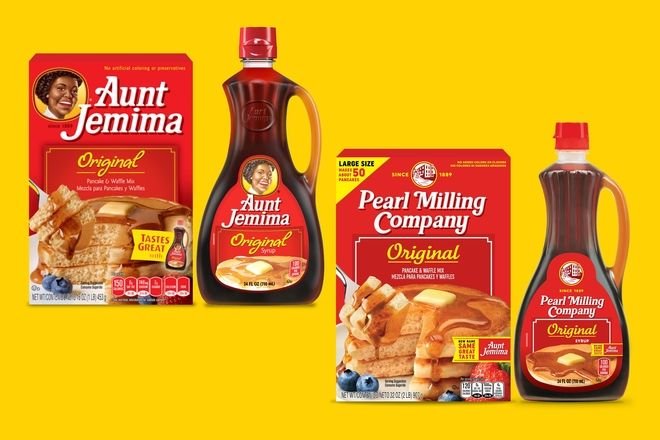
The COVID-19 pandemic has changed consumption and buying habits like never before. Consumers expect more and better from brands. Clients and brands alike have had to rethink the way they approach retail spaces. Today, a brand must not only create a retail space but think it, design it and give it meaning. We might think that e-commerce has put a strain on retail but, rest assured, this crisis has given birth to a lot of new perspectives for retail design.
To this day, it’s still difficult for retailers to get customers back into stores due to safety and security concerns. But on the other hand, consumers are storming into stores as a sign of a return to normal life. However, a new era is emerging. The era of Retail 3.0. The one where the consumer is in charge, where people understand that they have the power to make brands understand their needs.
Retail is no longer just about selling a product in a physical store, it is also about building a relationship between a brand and its audience.
Consumers no longer only want to be sold a product, they want to establish and build a real relationship with the brand. How? Through experience.
Customers are looking for experiences. Experiences they can’t get online. They want to be able to make it worth their time to go there. And it’s through design, that a brand can craft those experiences and meet that need, in whatever way possible. To do this, you must be able to project yourself. Question yourself and ask yourself: How will this space be crossed? What will the visitors feel? What will they experience? What is the attraction, beyond the products on sale? It is by answering these questions in an agile, realistic and relevant way that a brand can design experiences within its retail spaces.
How can you think about in-store experience without considering digital? Today, we have a lot of devices and tools at our disposal to bring to life experiences that take full advantage of new technologies. Digital can allow a space to exist beyond its limits. And this, by gathering and uniting in the service of experiences for well-being, for play, for learning.
Let’s take the Nike brand as an example. Fully turned towards the future and focused on digital, the brand has launched a brand new retail concept: the House of Innovation. Located in Paris, this store offers an immersive and digital journey from start to finish to its visitors. This is illustrated in particular by the installation of a control wall at the entrance, an interactive play area via terminals for children and many others…
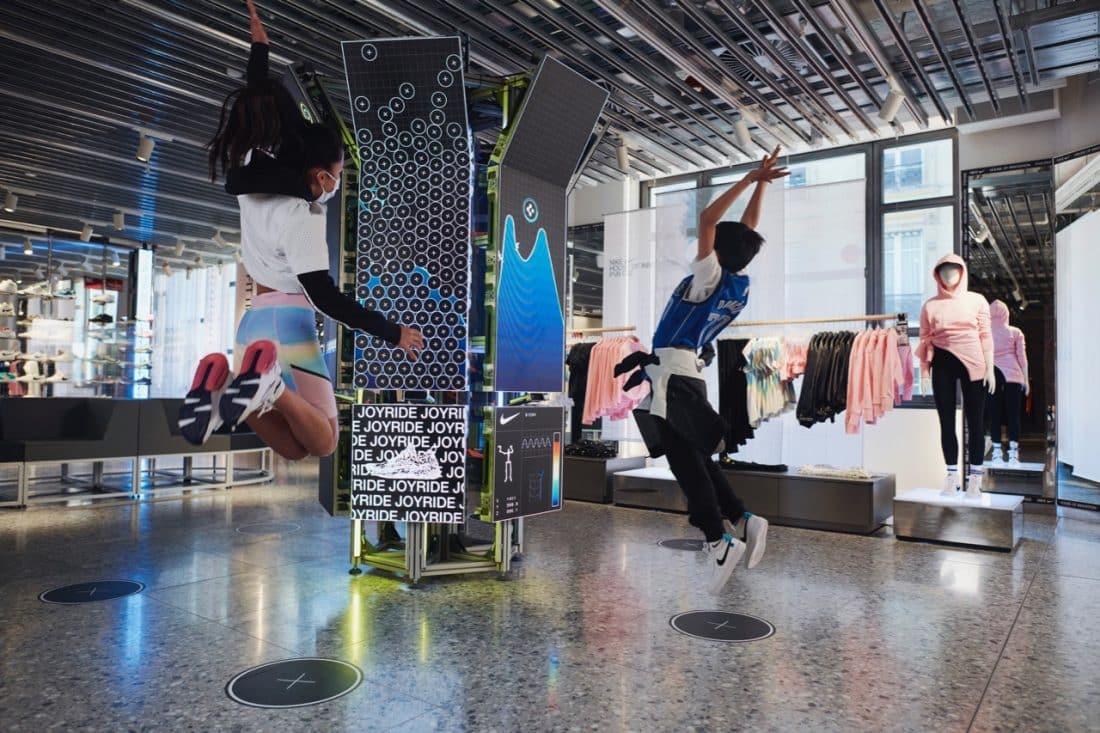
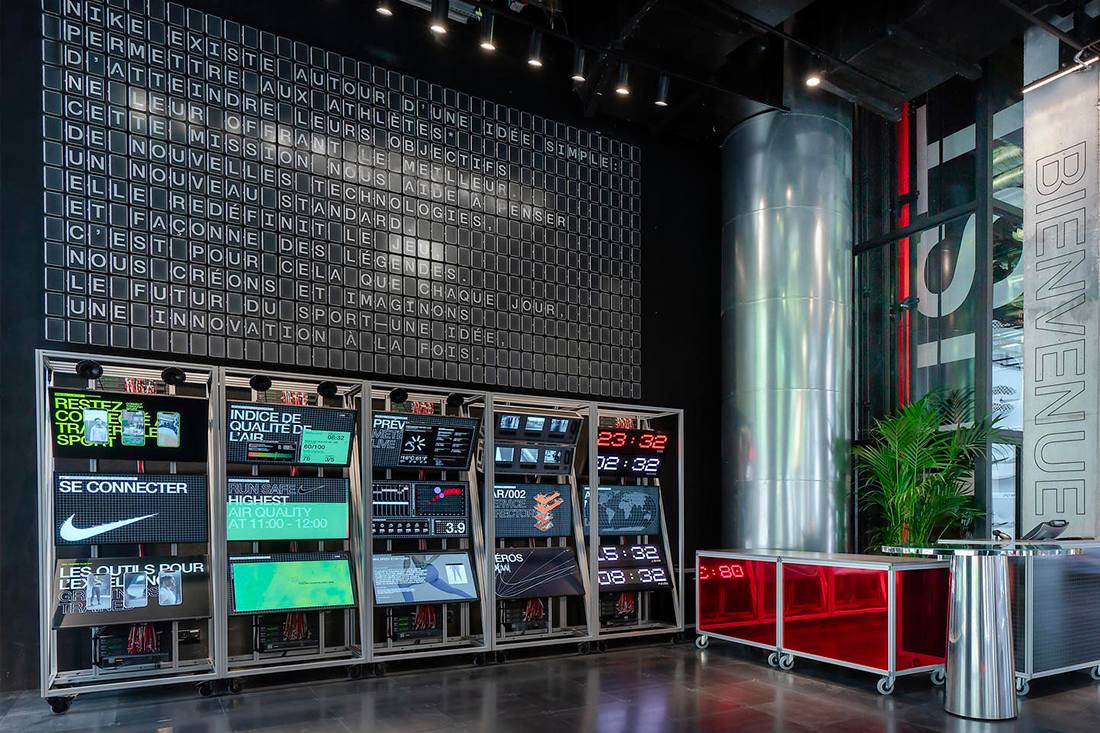
However, technology also has its limits. It should not be perceived as too intrusive and suffocating for customers. This is why it must be approached subtly, and not be placed in the foreground in a too direct way, but in the background.
With digital, brands can create magical experiences. Experiences where customers could feel like the space was designed especially for them. A place where they can feel good and that, of course, will make them want to come back. The brand can also see its benefit. By creating connected experiences within its spaces, it generates traffic to serve its strategy.
New technologies have given retailers a playground of limitless possibilities, and we are still far from seeing the end of it.
It’s not news, we are facing the biggest environmental crisis our planet has ever experienced. Beyond the implementation of CSR policies, brands must design retail spaces that respect the environment. Spaces with meaning, which will invite us to reflect and rethink our buying habits.
There is a real opportunity for brands to design for our collective future. This includes flexible and responsible spaces. But it is also illustrated by measures put in place to rethink the way we consume. For some brands, this will be the installation of refill stations within their spaces. Stations in order to refill our products (liquids, bulk…) rather than buying a completely new one which will consume much more plastic. This is the case for L’Occitane, which has installed refill fountains in more than 58 stores around the world. Retailers are also getting involved, including Monoprix, which has extended its refill service to other major grocery brands: Barilla pasta, salted biscuits Michel & Augustin, Krema et Lutti gummies… For other brands, it can also be spaces specially designed to allow their customers to give a second life to their used products.

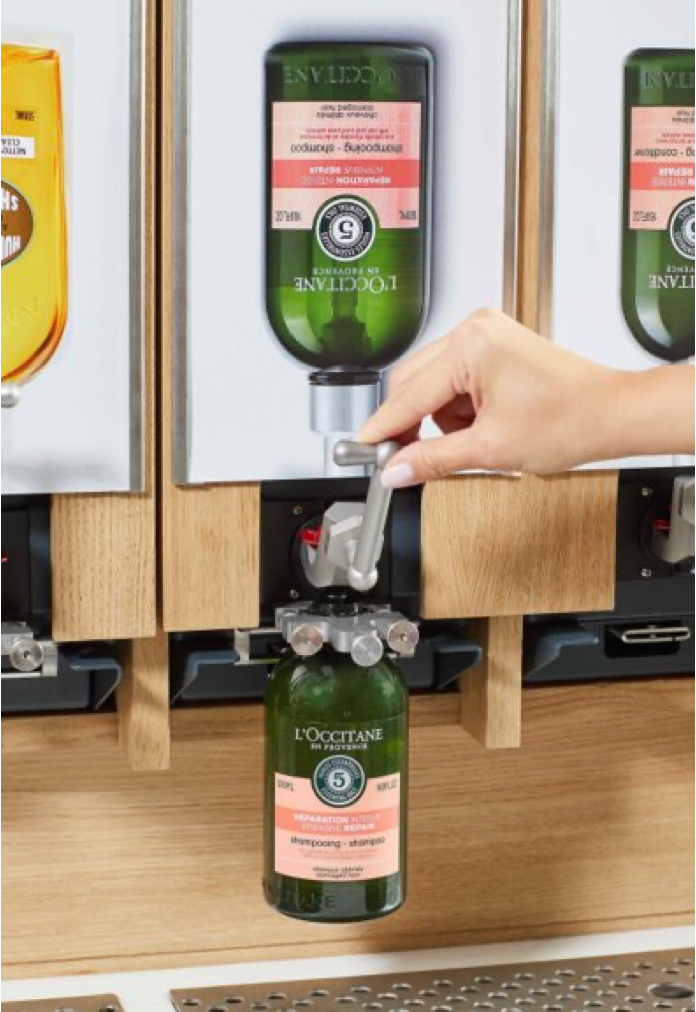
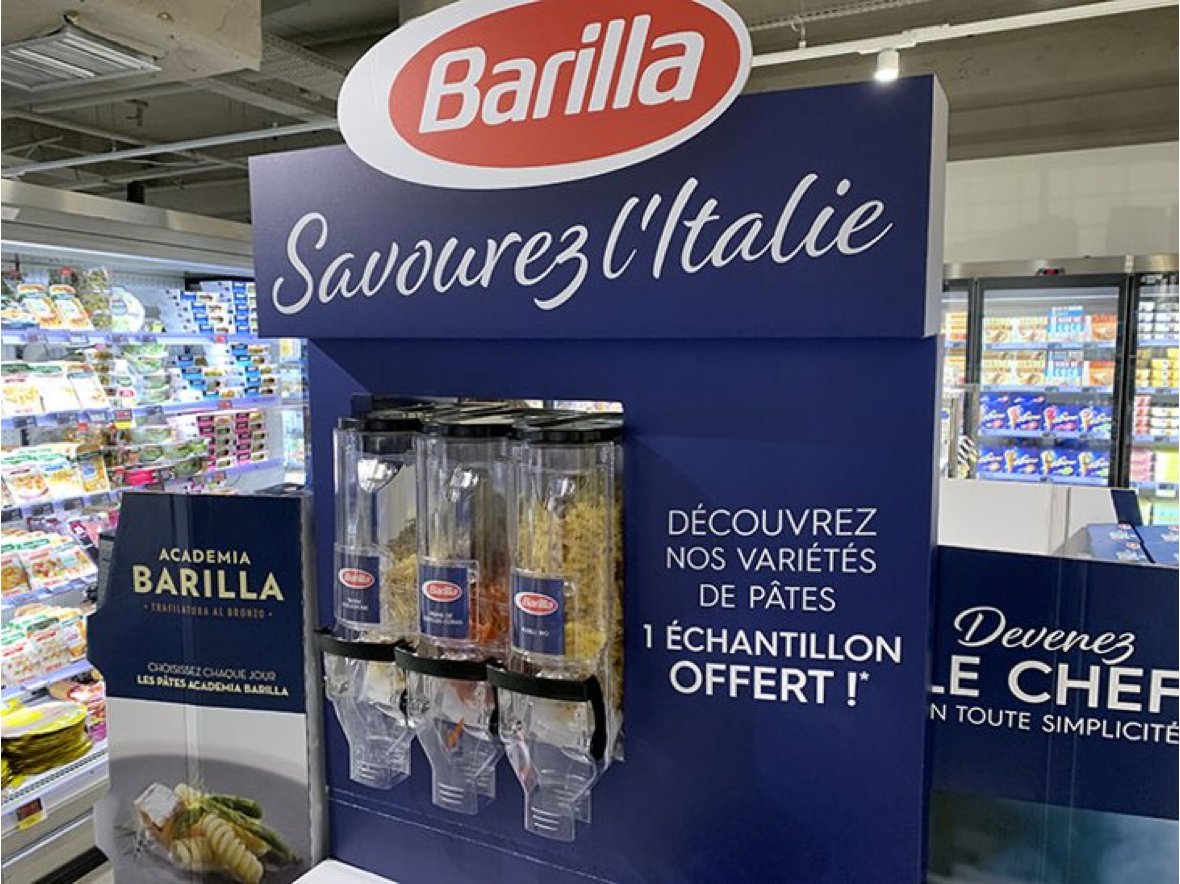

Finally, the retail space itself needs to be rethought. Because yes, the realization of retail spaces has a strong impact on our environment. It is therefore essential to integrate this aspect into the design of a project. The design as well as the materials used must be, as much as possible, respectful of the environment. This is not just another constraint for brands, but a real way to act and create value.
One thing is certain: the global pandemic did not mark the end of retail spaces. On the opposite, in fact. A second life is presented to it. A second wind to perpetually renew and reinvent itself.
Subscribe and receive CBA’s latest news directly in your inbox!
Privacy Overview
Subscribe and receive latest CBA news directly in your mailbox!